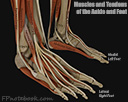II. Physiology
III. Causes
- Chronic overuse in age over 45 years
- Forced dorsflexion against resistance of a plantar flexed foot (eccentric stress on tibialis anterior tendon)
- Distance Running
- Soccer or football
IV. Risk Factors
- Women
- Overweight
- Runners (overuse injury, esp. with hills and increased mileage)
V. Symptoms
- Anterior ankle pain and medial midfoot pain
- Pain worse at night and also with activity
VI. Signs
- Pain (and possibly swelling) localized to the anteromedial ankle and foot overlying the anterior tibial tendon
- Palpable mass in low anterior leg if anterior tibial tendon rupture
- Weak and painful foot dorsiflexion on resistance
- Gait may demonstrate a Foot Drop or Slapping gait
- Passive Stretching of anterior tibial tendon may result in pain
- Plantar flexion
- Hindfoot eversion
- Midfoot abduction
- Ankle pronation
VII. Differential Diagnosis
- Anterior Tibial Tendon Rupture
- Lumbar Radiculopathy
- Peroneal nerve palsy
VIII. Complications
- Complete peroneal tendon rupture (more common in age >50-60 years)
IX. Management
- Ankle Foot Orthotic (for dorsiflexion assistance) OR
- Immobilization (e.g. CAM walker boot)
- Start with 3 weeks of immobilization
- Next 3 weeks
- Range of motion Exercises AND
- Immobilization (e.g. CAM Walker boot) with ambulation only
- Foot dorsiflexion strengthening
- Orthopedic referral indications
- Complete peroneal tendon rupture
- Refractory Anterior Tibial Tendinopathy
- Consider surgical Debridement for refractory symptoms >5 months
- Grundy (2010) Foot Ankle Int 31(3): 212-9 [PubMed]

